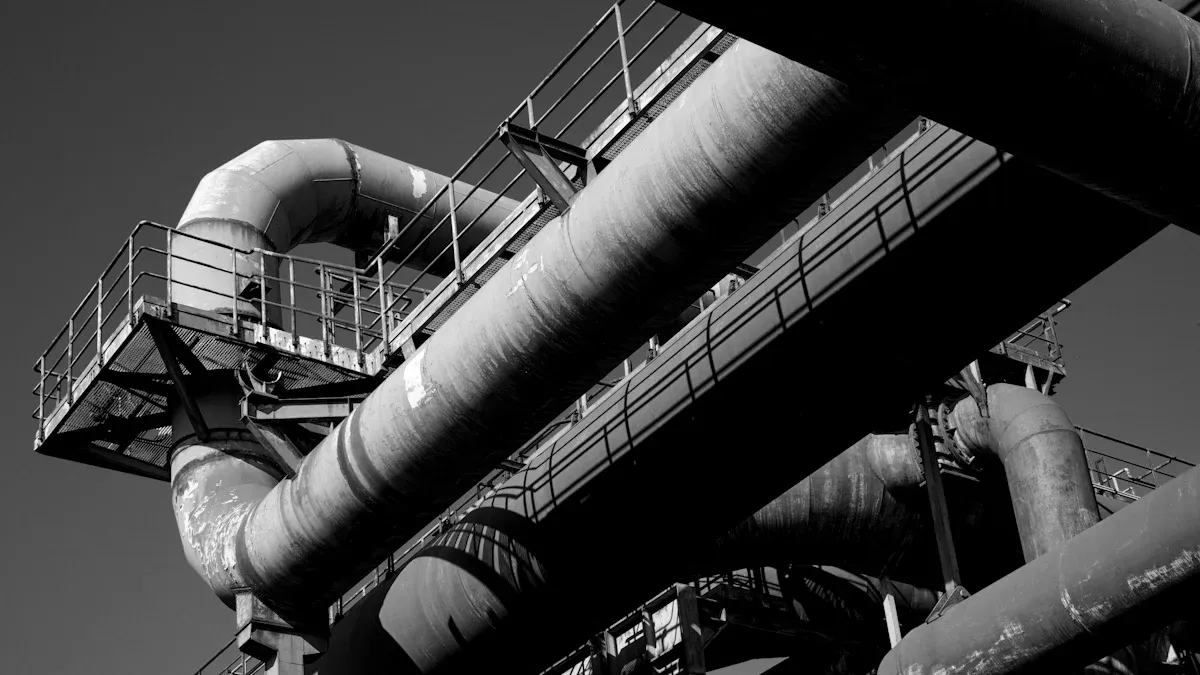High Strain Recovery Tubing Powers Modern Engineering Magic

High strain recovery tubing makes people see engineering in a new way. This material is very strong and can remember its shape. It is also tough and can bounce back. Engineers use it in many places where old materials do not work well. These old materials might not be strong or flexible enough. High strain recovery tubing goes back to its first shape after being stretched. This makes it good for hard engineering jobs.
Many important uses need materials that are very strong and can recover well, even if people cannot see these materials.
Key Takeaways
High strain recovery tubing is very strong. It can go back to its original shape after being stretched. This makes it great for hard engineering work.
This tubing lasts for a long time. It does not get damaged easily by stress, heat, or pressure. This means it needs fewer repairs.
Engineers use this tubing in many areas. These include water systems, energy, aerospace, and medical devices. It helps keep these systems safe and working well.
The tubing has special shape memory and superelasticity. These features help stop leaks and handle tough conditions. This saves money and helps the environment.
New ideas with this tubing help engineers make better designs. These designs are smarter, safer, and cost less. They also improve how things work and keep people safe.
What Is High Strain Recovery Tubing?

Key Properties
High strain recovery tubing is special in engineering. It is strong and can recover after being stretched a lot. This tubing uses special alloys like Nitinol. Nitinol has almost the same amount of nickel and titanium. Engineers pick these alloys because they are strong, bend easily, and last a long time. The tubing can stretch or bend when stressed. Afterward, it goes back to its first shape. This is called superelasticity.
How well the tubing works depends on what it is made of and how it is made. Changing the nickel-titanium mix or using different heat can change its strength. Some ways of making it, like Selective Laser Melting, make it harder and stronger. Engineers use tensile testing to see how much stress and strain the tubing can take before breaking. The stress-strain curve from these tests shows how the tubing acts under different loads. A true stress-strain curve gives a better idea of how the tubing works, especially when it stretches a lot.
Shape Memory Effect
The shape memory effect makes this tubing unique. When the tubing is stressed, its inside structure changes. At some temperatures, the tubing switches between two phases. These are called austenite and martensite. If the tubing bends or stretches, it forms martensite. When the stress goes away or the tubing is heated, it turns back to austenite. Then it gets its first shape again. This process makes a loop on the stress-strain curve. The loop shows how the tubing can recover from big stretches.
Engineers use tensile testing to look at this effect. They put stress on the tubing and see how much it can recover. The tubing can take high loads and still go back to its first shape. This makes it useful for projects that need both strength and flexibility.
Engineering Benefits
Durability and Longevity
High strain recovery tubing is special because it lasts a long time. It works well even when things get tough. Engineers use rotary bend fatigue testing to see how strong the tubing is. Nitinol is often used for this tubing. It can last through up to one billion test cycles. This means it can take a lot of stress and strain without breaking. The tubing is tested for both low and ultra-high cycle fatigue. These tests show it can avoid breaking from repeated use, especially if it does not change phases under stress.
Rubber-based tubing is also tested in labs. Machines like Moving Die Rheometers and universal testing machines check its strength and stretchiness. They also test how well it resists getting tired. These tests follow ASTM and ISO rules. Fatigue testing machines copy millions of stress cycles. This helps engineers know how the tubing will work over time. The tubing must keep working well, even in tough places.
Fatigue testing uses different methods. These include axial loading, rotating bending, and torsion fatigue. The tests make S-N curves. These curves show how much stress the tubing can take before it breaks. The curves help engineers find the tubing’s fatigue limit. This limit tells them the most stress the tubing can handle for many cycles. Both constant and changing loads are tested. This helps engineers guess how the tubing will work in real life.
Engineers trust high strain recovery tubing because it does not fail easily. It can resist problems like mechanical fatigue, creep rupture from heat, graphitization, weld failures, and stress cracking. The tubing’s design and tests help stop these problems. This makes it a good choice for long-term use.
Performance Under Stress
High strain recovery tubing works very well under big stress, strain, heat, and pressure. Strain-based design lets the tubing use all its strength, even past the elastic range. This means it can handle changes that happen in tough places, like thermal wells. Tests at 20 to 350°C show the tubing stays strong and saves money. The tubing can deal with strain localization, repeated plastic loading, and changes in strength from different strain rates. These things help the tubing work where other tubing would break.
The tubing also does well under high pressure. It keeps its shape and strength, even if the pressure changes fast. This makes it good for jobs that need strong tubing in hard conditions. The tubing’s tensile strength and ability to bounce back help stop leaks and breaks.
Engineers must watch for problems over time. These include mechanical fatigue, creep rupture, graphitization, weld failures, and stress cracking. For polyethylene tubing, slow crack growth, environmental stress cracking, and fast crack spreading are big worries. Regular checks help stop these problems.
Engineers do these maintenance steps:
Look for twisting, bending, and strain near hose ends.
Use covers like thermosleeves or fire jackets if needed.
Make regular inspection and replacement plans.
Check inspection data to change maintenance times.
Keep extra hoses for important systems.
These steps help stop delays and save money over time. Good care keeps things running well and the tubing working its best. High strain recovery tubing gives steady performance, needs fewer repairs, and helps keep engineering projects safe.
Applications

High strain recovery tubing is used in many important ways. It helps in building, energy, travel, and moving fluids. The tubing works well where there is high pressure or strong forces. It also works in places with tough weather or ground. Its special features help keep things safe and working, even after big events like earthquakes or hard hits.
Infrastructure
Cities and towns use high strain recovery tubing for water and wastewater pipes. This tubing, often made from HDPE, keeps water moving during earthquakes or ground shifts. The table below lists real projects that used this tubing and what happened:
Infrastructure Project / Location | Application of High Strain Recovery Tubing (HDPE) | Reported Performance Outcomes |
|---|---|---|
Christchurch Water Distribution Network, New Zealand | Replacement of damaged water pipelines with HDPE after 2010 Darfield earthquake | No repairs needed despite soil liquefaction and lateral spreading up to 2 m; maintained service continuity |
Los Angeles Aqueduct, San Andreas Fault Crossing, USA | Installation of ~900 mm HDPE pipelines in Elizabeth Tunnel crossing fault | Pipelines accommodate up to 2.5 m lateral fault displacement; reduce seismic risk; maintain water conveyance even if tunnel is cut off |
San Francisco Auxiliary Water Supply System, USA | Seismic retrofitting of critical water supply facilities using HDPE pipelines | Enhanced seismic resilience and ductility of pipelines under earthquake loading |
Laboratory and Centrifuge Testing at Cornell University and RPI | Large-scale soil-structure interaction and centrifuge tests on HDPE pipelines under simulated ground rupture | Demonstrated superior ductility and resilience; HDPE pipelines withstand large fault displacements without rupture; ovaling identified as main deformation mode |
University at Buffalo Shake Table Tests | Testing of pipelines with cured-in-place pipe (CIPP) linings and flexible electronics | CIPP linings provide substantial seismic strengthening and rehabilitation potential; flexible electronics enable real-time condition monitoring |
These projects show the tubing can handle ground shifts and pressure changes. The tubing keeps working, even if the ground moves more than two meters. Cities trust this tubing because it does not leak and lasts a long time.
Energy Systems
Energy systems need tubing that can take high pressure and big temperature changes. High strain recovery tubing is used in oil, gas, and geothermal work. People use it for pipelines, well casings, and heat exchangers. The tubing can go back to its shape after bending or stretching. This helps it last in hard places. It keeps fluids moving safely, even when pressure or temperature changes fast.
Engineers pick this tubing because it is easy to put in and works well. The tubing does not crack or break easily, so there are fewer repairs. In energy systems, stopping leaks is very important. The tubing makes a tight seal, so gas or liquid stays inside. This protects nature and saves money on fixing leaks.
Aerospace and Automotive
Aerospace and car engineers use high strain recovery tubing to make vehicles lighter and safer. Aluminum alloy tubes are used a lot in these jobs. These tubes weigh less than steel, so vehicles are over 40% lighter. Lighter vehicles use less fuel and can go faster. Engineers also use foam-filled tubes to soak up crash energy. These tubes fold and crush to keep people safe.
Special surface treatments, like grinding with graphene lubrication, make the tubes stronger. These treatments fix small problems and stop cracks from starting. The tubes last longer and work better under stress. The table below shows how these tubes help in aerospace and car work:
Aspect | Role in Aerospace and Automotive Engineering | Quantifiable Benefits |
|---|---|---|
Energy Absorption Mechanism | Foam-filled aluminum alloy tubes act as energy-absorbing components through plastic deformation modes such as collapsing, folding, and hinging. Foam filling enhances energy absorption beyond the sum of individual parts. | Energy absorption capacity increased by more than 2.5 times compared to empty tubes or foam alone. |
Load-bearing and Strain Hardening | Interaction between tube and foam increases load-bearing capacity and strain hardening. Predictive models incorporate strain hardening and inertia effects for accurate design under high-velocity impacts. | Extended densification strain up to 0.63, enabling higher energy absorption efficiency. |
Weight and Corrosion | Aluminum alloy tubes provide significant weight reduction (over 40%) compared to steel parts, improving lightweight design. Foam-filled tubes also show improved corrosion resistance. | Weight reduction exceeding 40%, improved corrosion resistance compared to traditional materials. |
Mechanical Properties Enhancement | Surface mechanical treatments under graphene lubrication improve yield strength and strain hardening capacity, reducing defects that cause cracking. | Enhanced yield strength and strain hardening capacity, mitigating crack initiation sites. |
High strain recovery tubing helps engineers make vehicles and planes that are safer, lighter, and work better.
Leak-Tight Gas Seal
Many jobs need a leak-tight gas seal to keep things safe. High strain recovery tubing makes a tight seal, even with high pressure or temperature changes. This tubing is used in gas pipes, chemical plants, and medical tools. The tubing’s shape memory effect helps it press tight against joints. This stops gas from leaking, even if the system moves or shakes.
Engineers trust this tubing because it keeps gas and fluids inside, even when pressure changes fast. This keeps workers, people, and nature safe. The tubing is easy to install, so workers save time and money. Its strong seal and ability to go back to its shape make it the best choice for leak-tight gas seals.
Advancing Engineering Design
Innovation
High strain recovery tubing lets engineers make new and clever designs. This tubing, usually made from nitinol, can bend and go back to its shape. Engineers use this to build things that change when stressed. Medical engineers use nitinol tubing for braided stents, guidewires, and implants. These devices bend to fit inside the body and then return to their shape. This makes surgery safer and helps people heal faster.
Engineers use high strain recovery tubing in:
Robotic surgical tools that move in small spaces.
Wearable medical devices that bend with the body.
Custom implants that fit a patient’s body.
Devices that give real-time feedback for accuracy.
New ways to make tubing, like laser cutting and 3D printing, help engineers design for special uses. The tubing’s superelasticity and shape memory let it handle stress and strain many times. Smart coatings and flexible electronics can be added to the tubing. These features let devices check their own condition and change as needed. This makes engineering work better and helps adaptive systems grow.
Smart materials like high strain recovery tubing help engineers make devices that react to their surroundings. This leads to safer and more dependable solutions.
Safety and Cost-Effectiveness
High strain recovery tubing makes many engineering jobs safer. It can recover from high stress and strain, so it does not break easily. This lowers the chance of accidents and keeps people safe. The tubing lasts a long time, so engineers do not need to replace it often. This saves money on repairs and cuts down on downtime.
Engineers trust this tubing because it works well in tough places. It does not rust and can handle changes in heat and pressure. These features help engineers build systems that last a long time. The tubing’s dependability means fewer repairs and less risk of leaks or breaks. This saves money and keeps people and nature safe.
Key benefits for engineering projects:
Works well under repeated stress and strain.
Lasts a long time and needs fewer replacements.
Saves money on repairs and boosts efficiency.
Makes things safer for workers and users.
Smart engineering uses high strain recovery tubing to balance safety, cost, and performance. This tubing helps engineers meet strict rules while keeping projects affordable and efficient.
High strain recovery tubing lets engineers fix hard problems. They use it to make strong systems that do not leak. These systems last for many years. It is easy to put in, so it saves time and money. This tubing helps keep projects safe. New ways to install it help engineers make better designs. Advanced materials like this tubing will change engineering in the future.
FAQ
What is high strain recovery tubing made from?
Most high strain recovery tubing uses special alloys like Nitinol. Nitinol has nickel and titanium. Some types use strong plastics like HDPE. These materials help the tubing go back to its shape after stretching.
How does high strain recovery tubing prevent leaks?
The tubing makes a tight seal by pressing on joints. Its shape memory effect helps it keep this seal, even after bending or stretching. This keeps gas and fluids inside the system.
Where do engineers use high strain recovery tubing?
Engineers use this tubing in water pipes, oil and gas lines, cars, airplanes, and medical devices. It works well where there is high pressure, strong forces, or lots of movement.
How long does high strain recovery tubing last?
Tests show this tubing can last through millions of stress cycles. It does not break, crack, or leak easily. Good care and regular checks help it last for many years.
Can high strain recovery tubing handle extreme temperatures?
Yes! High strain recovery tubing works in hot and cold places. It keeps its strength and shape, even when temperatures change fast.
Tip: Always follow the maker’s rules for putting in and caring for high strain recovery tubing to get the best results.
See Also
The Importance Of Nitinol Tubing In Medical Innovations
How Nitinol Tubing Drives Progress In Medical Technology
A Deep Dive Into Nitinol Tubing Uses In Healthcare

